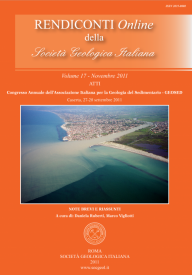
Il Geosito di "Calanche" (Campomaggiore, PZ): un tuffo nella Tetide tra gli Eventi Anossici Globali del Cretacico
Gallicchio S. (*) & Sabato L. (*)
(*) Dipartimento di Scienze della Terra e Geoambientali, Università degli Studi di Bari "Aldo Moro", Via E. Orabona 4, 70125 Bari. E-mail: s.gallicchio@geo.uniba.it; l.sabato@geo.uniba.it
Volume: 17/2011
Pages: 101-106
Abstract
The Geosite of "Calanche" (Campomaggiore, PZ): a dive in the Thetys between the Global Cretaceous Anoxic Events.
The Calanche area extends on the border between the villages of Campomaggiore and Albano di Lucania (PZ) and is characterized by the occurrence of unique stratigraphic and morphological
elements that can be considered as geological heritage. In this resort, a stratigraphic unit noted as "argille varicolori" (auctt.) crops out in a suggestive setting represented by badlands varying in colour from grey, to red, to green. The "argille varicolori" sedimentary succession cropping out in this site has taken in the recent years a role of fundamental importance for understanding the regional geology of the southern Apennines and the major Cretaceous climatic changes which affected the history of our Planet and the paleoceanography of the Tethys. In fact, along this sedimentary succession fi ve guidehorizons of particular scientific importance have been recognized.
These horizons, some decimeters thick, are characterized by the presence of radiolarites and black shales whose facies and ages allow us to attribute them to an ocean environment deeper than CCD surface, and which experienced relevant conditions of anoxia in certain intervals of time between Aptian and Turonian. Among these horizons, the most representative were correlated to the Selli and Bonarelli horizons, expression of the major Cretaceous Anoxic Oceanic Events occurred on the Earth respectively about 120 and 93 million years ago (OAE1a and OAE2).
The recognition of these horizons, as well as the extraordinary landscape of the badlands in which they are found, make unique and valuable the geodiversity of this area and allow us to ask the institutions for the establishment of a protected area. The aim is to preserve the geological heritage, which when equipped with didactic/educational panels, could be transformed into an important page in the evolutionary history of the Earth decipherable not only by a few specialists, but also by a wide and diversifi ed audience.
The proximity of this geological site to other places of geological, natural and cultural interests, occurring in the mid valley of the Basento River, enriches the offer of an already existing geoturistic tour and could represent an important opportunity for development of the nearby villages of Campomaggiore and Albano di Lucania, now at the edge of this tour.
Keywords
Get Full Text